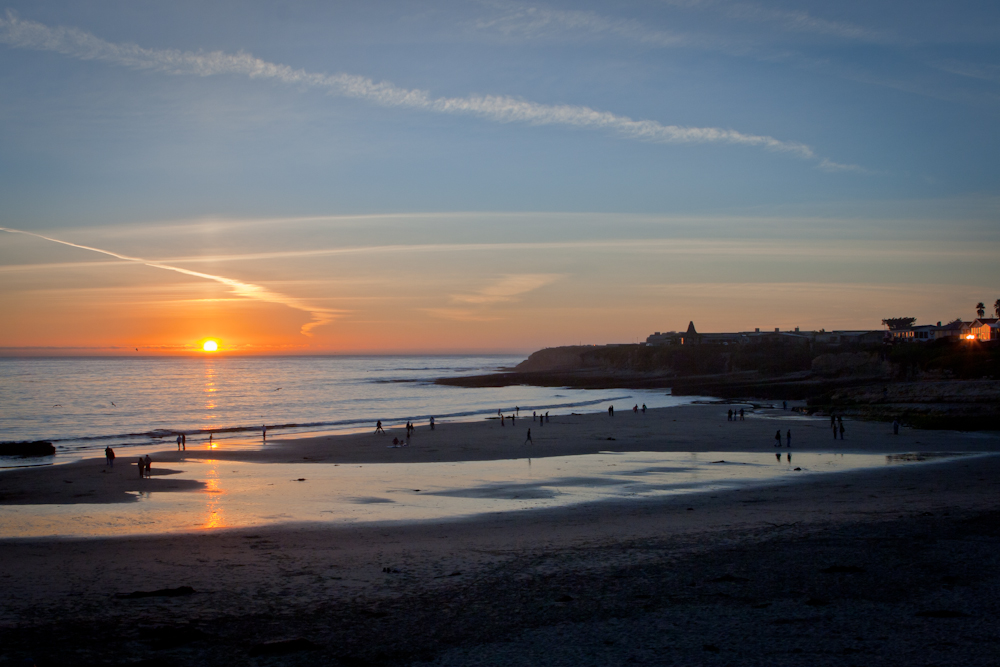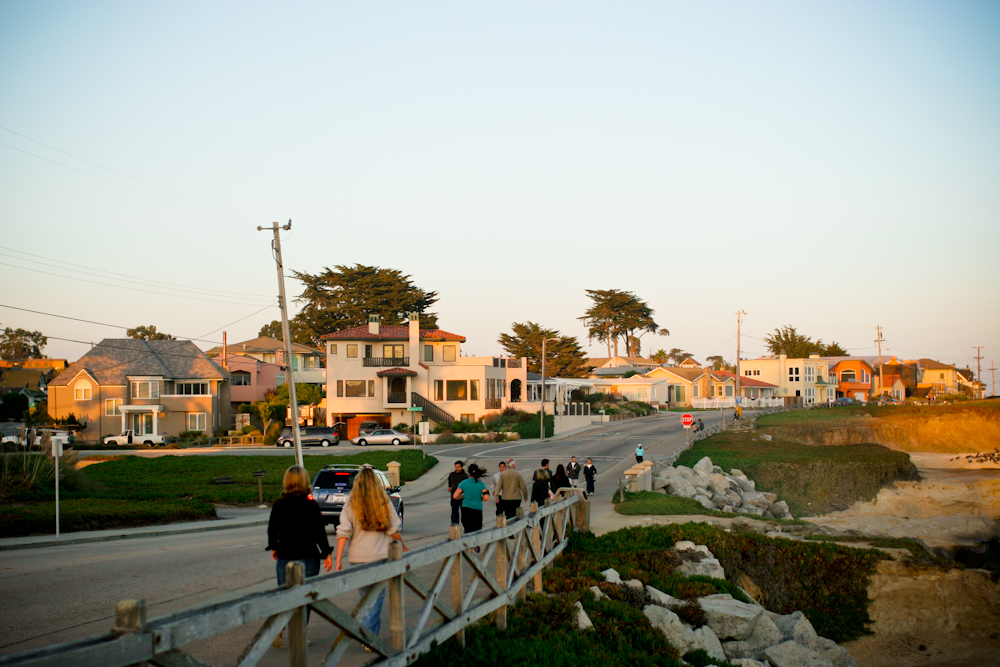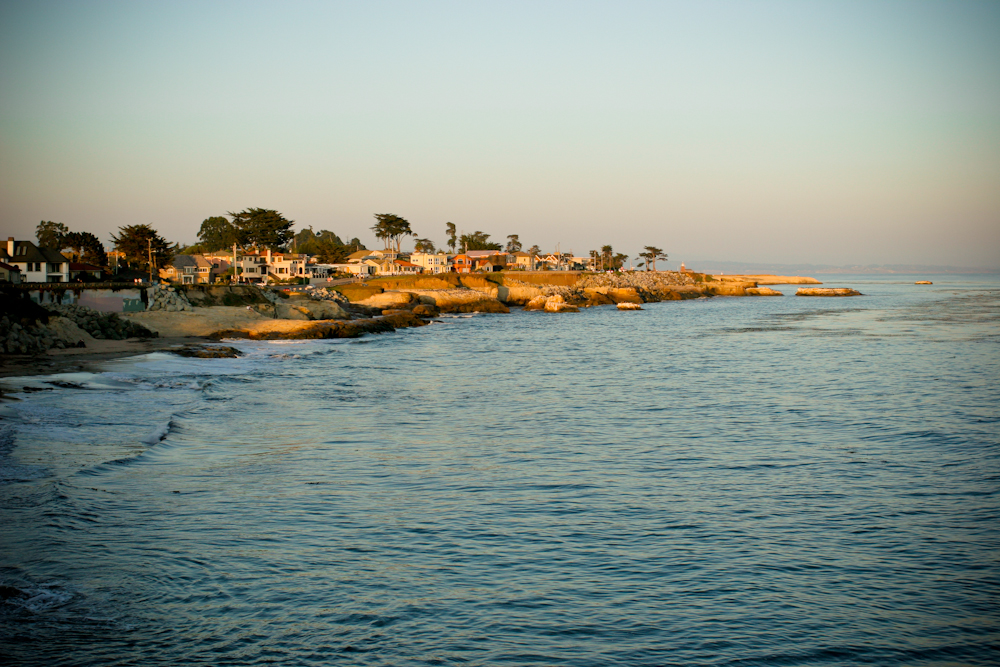Santa Cruz West Cliff Drive Adaptation and Management Plan
SB1 Adaptation Planning Grant: Final Case Study
Summary
The City of Santa Cruz (“City”) received a 2018-2019 Caltrans SB1 Adaptation Planning Grant to develop the West Cliff Drive Adaptation and Management Plan (“Plan”) to address threats to the transportation system from climate change using an “adaptation pathways” approach.
This Plan identifies climate threats, projected vulnerabilities and inventoried protective structures of West Cliff Drive. Informed by the vulnerability assessment, projections of future vulnerability, a cost benefit analysis and engagement with stakeholders, the Plan includes evaluation of adaptations, funding strategies, and concept plans for options to maintain the appropriate level of transportation infrastructure and service. Adaptations evaluated included natural or green infrastructure concepts, managed retreat concepts, and protective structures. The City used novel equity-based engagement strategies to support the process. The Plan also includes monitoring and policy recommendations, and near-term capital infrastructure plans.
The project began on October 1, 2018 and ended on March 31, 2021. All project deliverables can be found at www.cityofsantacruz.com/ResilientCoast.
Adaptation pathways is a planning approach that addresses the uncertainty and challenges of sea level rise and climate change decision-making (such as uncertainty in the regulatory, political, economic, environmental, and sociocultural conditions of the future). This approach, also called phased adaptation, enables consideration of multiple possible futures and more robust analysis of the benefits and downsides of adaptation solutions across those futures.
Lead Agency and Partnerships
The City of Santa Cruz was the lead agency. A multi-departmental City team collaborated with a consulting team (Integral Consulting, LLC) comprised of climate scientists, geomorphologists, transportation and geotechnical engineers, landscape architects, biologists and ecologists, economists, urban planners, and others, selected through a competitive RFP process to produce deliverables for this project. The project was guided by a 10 member Technical Advisory Committee, representing a variety of stakeholder and resident groups. Key stakeholders included California Coastal Commission, California State Parks and historically under-served and under-represented groups. Partnerships with community organizations were important to establish credibility and relationships with underrepresented groups. Academia (San Jose State University and University of California Santa Cruz) and interns brought more capacity to the project, enabling more targeted engagement and analysis.
Drivers
The West Cliff Drive Management Plan had long been called out for development in the City’s Local Coastal Program but funding and staffing capacity challenges had stalled previous efforts. The SB 1 Caltrans Adaptation Planning Grant Program enabled the city to gain the expertise and capacity to build on the momentum and relationships it had developed through the Local Hazard Mitigation Plan and Climate Adaptation Plan Update, both adopted in 2018. Moreover, the California Coastal Commission was eager for the City to complete the Plan to resolve outstanding permitting issues for emergency revetment repairs.
A revetment is a retaining wall or facing of masonry or other material, supporting or protecting a rampart, wall, or other structure, such as a barricade of earth or sandbags.
Public Engagement
The engagement for this project was coordinated with a complementary Local Coastal Program amendment project funded by the Coastal Commission, allowing the project to benefit from a dedicated engagement consultant at no charge to the CalTrans project, resulting in two well-coordinated projects, called the Resilient Coast Santa Cruz Initiative.
Building on the City’s Climate Adaptation Plan Update (2018) engagement, the team designed a living Engagement Plan that resulted in over 1,500 conversations with community members and stakeholders at over 50 meetings and events. The team employed a number of engagement strategies, and pivoted to online engagement with the advent of COVID-19. Promotion for each major engagement event was extensive and included flyers at public locations, emails to 300 person contact list, advertisements in local newspapers and community event calendars, Facebook postings and ads, and partnering with local community groups to share information through their networks. The City coordinated with a Spanish language translator and advisor, and provided materials in English and Spanish. This effort was increased multifold with COVID-19 to try and reach people who typically are uncomfortable or unable to use digital tools. The range of tools utilized were all accessible from the Initiative’s website www.cityofsantacruz.com/ResilientCoast. A google analytics report indicates that visits to the webpage increased by 10 fold in the transition between in-person to virtual engagement and due to the increase in promotion.
The graphic to the right documents how each engagement contributed to the key components of the two Resilient Coast Santa Cruz Initiative projects.
The goal of the engagement was to build trust, educate, and engage with a wide cross section of the community including many more vulnerable groups who traditionally may have been ignored. This equity aspect of the project was led by the City and is detailed in the overall Engagement Synthesis report found at the project website. Further documentation on how the input from historically under served and under represented groups was integrated into the plan development is included in the Urban Climate Adaptation Policy Implication and Response Strategy Evaluation Technical Report developed for the complementary Coastal Commission funded project resulting in a Local Coastal Amendment with sea level rise policies. A full list of groups engaged is contained in the Engagement Synthesis document.
Climate Impact Area
The resulting West Cliff Drive Adaptation and Management Plan focused on the impacts of sea level rise and erosion exacerbated by increased coastal storm wave forcing on coastal assets, including bluffs, cliffs, ecosystems, beaches, revetments, transportation corridors, recreation, accessibility, and more.
The project developed detailed coastal asset inventories and condition summaries, projections of future erosion, and a detailed near term plan to address vulnerabilities and exposure. It also documented the community’s perspectives on various adaptation strategies (e.g., retreat, accommodate and protect) and identified policies and projects that will enable transition from short term adaptations to more preferable medium term adaptations.
The project also included developing a monitoring component to be refined and implemented post-project. A summary of possible planning triggers () is included in the draft plan.
This project did not have a direct greenhouse gas emissions reduction component. However future living shoreline applications that may be result from subsequent planning efforts could improve carbon sequestration in the City.
Triggers are measurable indicators of change used to inform planning decisions as part of the “adaptation pathways" approach to planning for the impacts of climate change.
Funding Source
The project received a $342,741 CalTrans Adaptation Planning Grant Program award. The California Coastal Commission provided $70,100 to support engagement for the Local Coastal Amendment and Resilient Coast Santa Cruz initiative. The City also brought a substantial labor match of $97,693 to the project.
Research and Data
The City referenced the following State and Federal sea level rise and adaptation planning guidance documents:
- Ocean Protection Council (OPC) State of California Sea-Level Rise Guidance (2018),
- California Natural Resources Agency (CNRA) Safeguarding California Plan (2018),
- The California Coastal Commission (CCC) Sea Level Rise Policy Guidance (2018),
- Federal Highway Administration (FHWA) Adaptation Decision-Making Assessment Process (2016)
Challenges
The ability to reach under represented groups proved to be very challenging despite many modalities used and targeted investments for this purpose.
Overall, the project proved to be enormously more time consuming than the City had estimated for the proposal. A $44,000 staff labor match was proposed and the actual staff labor match was over $93,000.Engagement and coordination of multiple internal and external stakeholder groups was also more extensive than anticipated.
There was a steep learning curve both for local city staff and the local Coastal Commission office on integrating adaptation pathways and triggers into planning documents.
Fortunately, the project benefitted from the coordination with the complementary Coastal Commission project under Resilient Coast Santa Cruz, gaining efficiencies with the Coastal Commission and others as a stakeholder group. Close coordination with these groups ensured local alignment on final project deliverables. Last, the project coordination team gathered extensive data on what worked and what did not and will plan future engagements with this information.
Outcomes
The project included a cost benefit analysis completed by the Middlebury Institute. The City will begin refining the cost estimates and funding strategy to begin implementing the Plan after it is adopted. The following list of deliverables were completed in partnership with the consultant and community.
- TAC Agendas
- Community Meeting Agendas
- Council and Commission Agendas and Minutes
- Project website
- Existing Conditions Inventory and Base Condition Assessment Report
- Transportation Facilities Inventory and History
- Alternatives Analysis report
- Monitoring plan and Trigger thresholds memo
- Conceptual Design Package
- Cost/Benefit Analysis Memo
- Draft West Cliff Drive Adaptation and Management Plan
- Final West Cliff Drive Adaptation and Management Plan
Replicability
The West Cliff Drive Adaptation and Management Plan has potential for replicability for any community with transportation networks adjacent to a vulnerable coastline. Threats from sea level rise are imminent, and communities must characterize these vulnerabilities, develop adaptation strategies will need to be implemented and build community consensus around technically and economically feasible options. The West Cliff Drive Adoption and Management Plan will be a guide for other vulnerable communities facing similar challenges.
Additional Resources
All project deliverables can be found at www.cityofsantacruz.com/ResilientCoast.
2018-2023 Climate Adaptation Plan Update (English)
2018-2023 Climate Adaptation Plan Update (Spanish)
2018-2023 Local Hazard Mitigation Plan Update
Further Information
For questions about this project, contact Dr. Tiffany Wise-West, Sustainability & Climate Action Manager, TWise-West@cityofsantacruz.com.

